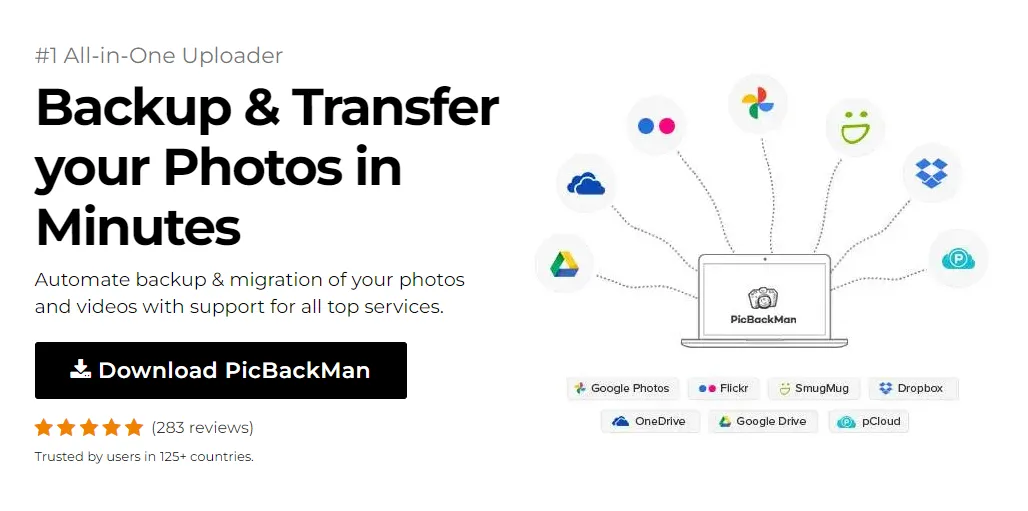Why is it the #1 bulk uploader?
- Insanely fast!
- Maintains folder structure.
- 100% automated upload.
- Supports RAW files.
- Privacy default.
How can you get started?
Download PicBackMan and start free, then upgrade to annual or lifetime plan as per your needs. Join 100,000+ users who trust PicBackMan for keeping their precious memories safe in multiple online accounts.
“Your pictures are scattered. PicBackMan helps you bring order to your digital memories.”
It shows only 5000 pics queued, I have lot many. Why?
In the digital age, our photo collections have grown exponentially. With high-quality cameras in our pockets and the ease of taking multiple shots, it's not uncommon for individuals to amass thousands of pictures. However, many users encounter a perplexing issue: their devices or photo management software only show 5000 pictures in the queue, despite having a much larger collection. This article delves into the reasons behind this limitation and offers solutions to manage your extensive photo library effectively.
The phenomenon of seeing only 5000 pictures queued when you have many more is a common issue that stems from various factors. This limitation is often not a glitch but a deliberate design choice by device manufacturers or software developers. The reasons behind this cap can range from performance optimization to user experience considerations.
One primary reason for this limit is to ensure smooth performance across different devices. Loading and displaying thousands of high-resolution images simultaneously can be resource-intensive, potentially leading to slow response times or crashes, especially on older or less powerful devices. By limiting the queue to 5000 images, developers can guarantee a more consistent and responsive user experience across a wide range of hardware configurations.
Additionally, this limit may be in place to encourage better photo organization and management practices. With a cap on visible images, users are prompted to regularly sort, delete, or archive their photos, preventing the accumulation of an unwieldy and disorganized collection.
Understanding Device and Software Limitations
Different devices and software applications have varying capabilities when it comes to handling large photo libraries. While some high-end smartphones and tablets can smoothly manage tens of thousands of images, others may struggle with such vast collections. Similarly, cloud storage services and photo management software often have their own limitations and optimization strategies.
For instance, Apple's iCloud Photo Library syncs your entire photo collection across devices but may limit the number of thumbnails displayed at once to conserve bandwidth and improve loading times. Google Photos, on the other hand, offers unlimited storage for "high quality" (compressed) photos but may impose limits on the number of images that can be viewed or edited simultaneously within the app.
Understanding these limitations can help you choose the right tools and strategies for managing your photo collection effectively.
Quick Tip to ensure your videos never go missing
Videos are precious memories and all of us never want to ever lose them to
hard disk crashes or missing drives. PicBackMan is the easiest and simplest
way to keep your videos safely backed up in one or more online accounts.
Simply Download PicBackMan (it’s
free!), register your account, connect to your online store and
tell PicBackMan where your videos are – PicBackMan does the rest,
automatically. It bulk uploads all videos and keeps looking for new ones and
uploads those too. You don’t have to ever touch it.
The Role of File Formats and Image Sizes
The file format and size of your images play a crucial role in how many pictures can be queued and displayed efficiently. High-resolution DSLR photos in RAW format, for example, are significantly larger than compressed JPEG images taken with a smartphone. This size difference impacts not only storage requirements but also the processing power needed to handle these files.
Some photo management systems may prioritize newer or more frequently accessed images, pushing older or rarely viewed photos to the background. This can create the illusion of a limited queue, even when your entire collection is technically accessible.
To optimize your photo library:
- Consider converting RAW files to JPEG for everyday viewing
- Use lower resolution copies for browsing, keeping high-res originals for editing
- Regularly review and delete duplicate or unnecessary images
By managing your file formats and sizes thoughtfully, you can potentially increase the number of images that your device or software can efficiently queue and display.
Syncing Issues and Cloud Storage Challenges
In our interconnected digital ecosystem, many users rely on cloud storage services to keep their photo collections synchronized across multiple devices. However, this convenience can sometimes lead to the 5000 picture queue limitation.
Cloud syncing algorithms often prioritize recent or frequently accessed photos to ensure quick access to the most relevant content. This can result in older photos being temporarily unavailable or not showing up in the main queue. Additionally, slow or unreliable internet connections can hinder the syncing process, leading to incomplete photo libraries on some devices.
To address syncing issues:
- Ensure all devices have a strong, stable internet connection
- Manually trigger a sync if automatic syncing seems incomplete
- Check your cloud storage settings to confirm that all folders are set to sync
Remember that some cloud services offer "smart storage" options that automatically offload full-resolution photos from your device to save space, keeping only lower-resolution previews locally. This feature can sometimes create the impression of a limited photo queue.
Optimizing Your Photo Management Workflow
To effectively manage a large photo collection that exceeds the 5000 picture queue limit, it's crucial to develop an optimized workflow. This approach not only helps you navigate the technical limitations but also improves your overall photo organization.
-
Regular Culling: Set aside time periodically to review your photos and delete unnecessary duplicates or low-quality shots. This practice keeps your collection manageable and ensures that your queue contains your best and most meaningful images.
-
Smart Albums and Tagging: Utilize smart albums or tagging features in your photo management software. These tools allow you to quickly access specific subsets of your photos without scrolling through your entire collection.
-
Archiving Older Photos: Consider archiving older or less frequently accessed photos to external hard drives or long-term cloud storage solutions. This strategy keeps your active queue more manageable while preserving your complete photo history.
-
Leveraging Multiple Devices: If possible, spread your photo collection across multiple devices. For example, use your smartphone for recent photos and a tablet or computer for accessing your broader archive.
-
Exploring Third-Party Apps: Investigate third-party photo management applications that may offer more flexible queuing options or better handling of large photo libraries.
By implementing these strategies, you can work around the 5000 picture queue limitation while maintaining easy access to your entire photo collection.
Technical Solutions to Expand Your Photo Queue
For those determined to break past the 5000 picture queue limit, there are several technical solutions worth exploring. These approaches may require more advanced skills or the use of specialized software, but they can significantly enhance your ability to manage and access larger photo collections.
-
Database Optimization: Some photo management software uses databases to catalog and organize images. By optimizing these databases or increasing their capacity, you may be able to expand the number of photos that can be queued simultaneously.
-
Custom Scripts and Automation: Tech-savvy users can create custom scripts or use automation tools to rotate images in and out of the active queue automatically. This method ensures that all photos are accessible over time, even if not all at once.
-
Network-Attached Storage (NAS): Investing in a NAS device can provide a centralized storage solution for your entire photo collection, often with more flexible queuing options than standard cloud services.
-
API Integration: Some cloud storage providers offer APIs that allow developers to create custom solutions. If you have programming skills or can hire a developer, you might be able to build a tailored system that better handles your large photo collection.
-
Distributed Storage Systems: Advanced users might consider setting up a distributed storage system across multiple devices or servers, allowing for more efficient management of extensive photo libraries.
While these solutions require more technical expertise, they offer powerful ways to overcome the limitations of standard photo management systems and queues.
The Future of Photo Management: AI and Machine Learning
As we look to the future, artificial intelligence (AI) and machine learning technologies promise to revolutionize how we manage and interact with large photo collections. These advancements may eventually render the 5000 picture queue limitation obsolete.
AI-powered photo organization systems are already beginning to emerge, offering features like:
- Automatic categorization and tagging of images based on content
- Intelligent search capabilities that can find specific photos based on natural language queries
- Predictive loading that anticipates which photos a user is likely to access next
These technologies could potentially allow for more efficient handling of massive photo libraries, dynamically adjusting the queue based on relevance and user behavior rather than relying on arbitrary numerical limits.
Moreover, advancements in compression algorithms and storage technologies may soon make it feasible to keep entire photo collections readily accessible without compromising device performance or user experience.
As these technologies mature, users can look forward to more seamless management of their ever-growing photo collections, potentially eliminating the need to worry about queue limitations altogether.
FAQs
How do I transfer photos directly to my iPad?
To transfer photos directly to your iPad, you can use several methods:
1. Use iCloud Photo Library to sync photos across your devices automatically.
2. Connect your iPad to your computer and use iTunes or Finder (on macOS Catalina and later) to sync photos.
3. Use AirDrop to wirelessly transfer photos from your iPhone or Mac to your iPad.
4. Email photos to yourself and save them on your iPad.
5. Use third-party cloud storage services like Google Photos or Dropbox to upload and access your photos on your iPad.
How do I transfer photos from iPad to computer without iTunes?
You can transfer photos from your iPad to your computer without iTunes using these methods:
1. Use iCloud Photo Library to sync photos automatically if you’re on a Mac.
2. Connect your iPad to your computer and use the Photos app (on Mac) or File Explorer (on Windows) to import photos directly.
3. Use AirDrop if you’re transferring to a Mac.
4. Upload photos to a cloud service like Google Drive or Dropbox, then download them on your computer.
5. Email photos to yourself and download them on your computer.
How do I share photos between iPad and laptop?
Sharing photos between your iPad and laptop can be done in several ways:
1. Use iCloud Photo Library to keep photos synced across devices.
2. Use AirDrop for quick wireless transfers if you have a Mac laptop.
3. Share via cloud services like Google Photos, Dropbox, or OneDrive.
4. Use the Files app on your iPad to transfer photos to a connected external drive, which you can then access on your laptop.
5. Email photos to yourself and access them on both devices.
6. Use third-party file transfer apps like Send Anywhere or Documents by Readdle.
How to transfer files from iPad to PC using USB?
To transfer files from iPad to PC using USB:
1. Connect your iPad to your PC using a USB cable.
2. On your iPad, tap “Trust This Computer” if prompted.
3. On your PC, open File Explorer.
4. Look for your iPad under “This PC” or “Computer”.
5. Double-click on the iPad icon to access its contents.
6. Navigate to the “Internal Storage” > “DCIM” folder to find your photos.
7. Copy the desired files from your iPad to your PC by dragging and dropping or using copy/paste commands.
What is the best way to transfer files from PC to iPad?
The best way to transfer files from PC to iPad depends on your specific needs, but here are some effective methods:
1. Use iCloud Drive: Enable iCloud Drive on both devices and save files to it from your PC for access on your iPad.
2. iTunes File Sharing: Connect your iPad to your PC, open iTunes, select your device, go to File Sharing, and add files to compatible apps.
3. Use cloud services like Dropbox or Google Drive: Upload files on your PC and access them via the respective app on your iPad.
4. Email files to yourself and open them on your iPad.
5. Use third-party file transfer apps like Documents by Readdle or FileBrowser.
6. For large files or frequent transfers, consider using a wireless hard drive that creates its own Wi-Fi network for file sharing.
How do I drop files from PC to iPad?
To drop files from your PC to your iPad:
1. iCloud Drive: If you use iCloud, simply drag and drop files into the iCloud Drive folder on your PC. They’ll appear in the Files app on your iPad.
2. Cloud services: Drag files into your Dropbox or Google Drive folder on your PC, then access them through the respective app on your iPad.
3. AirDrop (for Mac users): Enable AirDrop on your iPad, then drag files onto the AirDrop icon in Finder on your Mac.
4. iTunes File Sharing: Connect your iPad, open iTunes, go to your device’s File Sharing section, and drag files directly into app folders.
5. Use a file transfer app: Some apps allow you to set up a local network or web interface where you can drag and drop files from your PC browser to your iPad.
Remember, the iPad’s file system is more restricted than a PC’s, so files may need to be opened with specific apps once transferred.
Conclusion
The issue of seeing only 5000 pictures queued when you have many more is a complex one, rooted in technical limitations, performance considerations, and user experience design. While it can be frustrating for users with extensive photo collections, understanding the reasons behind this limitation can help in developing effective strategies to manage your digital memories.
By employing a combination of smart organization techniques, leveraging available technologies, and staying informed about emerging solutions, you can effectively navigate this challenge. Remember that the goal is not just to see all your photos at once, but to have meaningful and efficient access to your cherished memories when you need them.
As technology continues to evolve, we can anticipate more sophisticated solutions that will make managing large photo collections even easier. Until then, a thoughtful approach to photo management can help you make the most of your digital archive, ensuring that your memories are always at your fingertips, regardless of arbitrary queue limitations.






